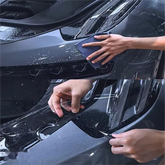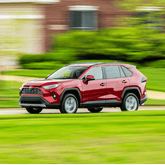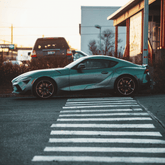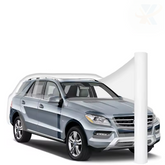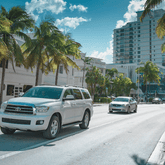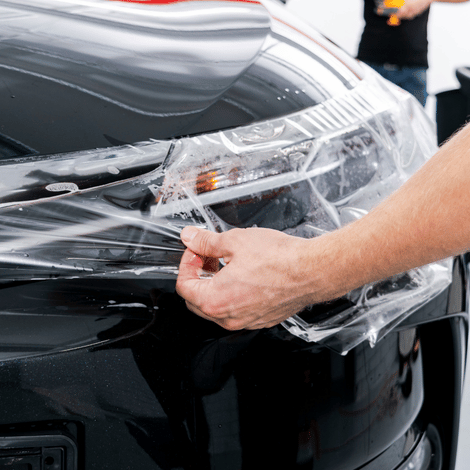Ultimate Guide to Choosing the Best Paint Protection Film Package for Your Vehicle
As cars have become more than just a means of getting from point A to B but are now considered major investments, it becomes increasingly important to shield their exteriors from environmental harm. This guide will discuss choosing the best paint protection film package for your vehicle’s needs. It will cover different kinds of films available in the market, how they are applied and what you should consider for durability and beauty. Readers will learn about technical details and options to protect their vehicles against scratches, UV radiation, and other damaging factors.
What is a Paint Protection Film (PPF)?

Understanding PPF and Its Benefits
Paint Protection Film (PPF) is a clear thermoplastic urethane that works as a shield for the paint of a car from outside elements. It can take in small debris and protect against scratches, chips, and stains. One of the main advantages of PPF is its ability to heal itself; minor scratches can disappear when exposed to heat. Moreover, PPF gives UV protection, preventing the paint from fading and oxidizing due to sunlight exposure. This film also keeps the shiny look on cars while being easy to remove or change without damaging the original coat beneath it. In short, putting money into PPF not only beautifies your vehicle for longer periods but also retains its resale value with time.
Common Uses and Applications of Paint Protection Films
Paint Protection Films (PPF) are becoming more commonly used in different situations to shield a vehicle’s surface from damage. These films are often applied to high-traffic areas such as the hood, bumper, fender, and side view mirror, where chips and scratches are likely to occur. Also, PPF is used to protect cars that operate in tough environments, such as those that frequently encounter road debris or gravel or experience extreme weather, so as to keep them looking good.
Another important application for paint protection film is within the automotive aftermarket industry since many car enthusiasts and collectors use it on their vehicles not only because they want them preserved but also due to its ability to increase resale value. In addition, PPF can be tailored according to thickness level as well as finish type, i.e., matte versus glossy option, thus making this product suitable for customization purposes. All in all, the protective features of PPFs make them worth buying by anyone who wants their vehicle’s lifespan extended while still maintaining its aesthetic appeal under various driving conditions.
How Does Paint Protection Film Work?
Paint Protection Film (PPF) is a shield between the car paint and external elements through advanced polymer technology and adhesive properties. The film is made of thermoplastic urethane, which provides durability and flexibility that allows it to adapt to different shapes of vehicles. Once applied, the adhesive layer sticks firmly onto the paint so there are no chances for lifting or peeling.
The PPF’s ability to self-heal from light scratches and swirl marks due to its elastomeric properties strengthens its defense capabilities. When exposed to heat like sunlight, this film expands and then returns back into shape, thereby “healing” minor imperfections on its surface. More importantly, though, is high optical clarity, where PPF lets you see through your original automobile color while protecting against ultraviolet radiation, environmental pollutants as well as physical abrasions at an exceptional level, thus making our cars last longer even though they look better than ever before.
How Do Different PPF Packages Vary?

Overview of Full Front PPF Packages
Full frontal paint protection film (PPF) packages cover the most exposed sections of a vehicle. This includes areas such as the hood, front fenders, front bumper, and side mirrors, which are prone to damage like stone chips or insects, among other road debris that might harm your car’s paintwork. The idea is to provide comprehensive coverage for these vital parts since they face harsh driving conditions often experienced by some drivers.
There are several options when it comes to full-front ppf packages in terms of what should be covered within them. Some installations may add on more components, such as headlights or windshield pillars, so as to offer extra security against damages caused by external forces like weather elements. Others can change depending on brand choice, leading to variations in features such as thickness, self-healing capabilities, warranty periods, etcetera but all serve one purpose – ensuring critical areas remain protected from hazards while maintaining aesthetics value over time, thus making you get back your money if ever sold after usage period has ended .
Exploring Partial Front PPF Options
When it comes to paint protection film (PPF), partial front options offer a customized choice for car owners who want to shield certain spots without the all-around cover of a full front package. Usually, these alternatives concentrate on areas that are highly impacted, like hoods and bumpers, but do not cover other susceptible places, such as fenders or mirrors. This kind of coverage is beneficial for drivers operating mainly in low-risk environments or those trying to save some money.
Moreover, different brands exist in the market, causing differences in thickness, durability, self-healing capacities, and resistance against scratches, among other things. To sum up, vehicle owners can choose partial front PPFs that allow them to balance safety and cost while protecting important regions competitively and economically.
Features of Full Vehicle PPF Package
A full vehicle Paint Protection Film (PPF) package covers the entire exterior section of a car. It protects against different environmental hazards. The most important features are:
- Comprehensive Coverage: A full vehicle PPF package is different from partial options in that it protects every painted surface, even those areas that are more prone to scratches such as doors, rear bumpers and side mirrors. This ensures equal defense against road debris or UV damage.
- Advanced Materials: Durable thermoplastic urethane is used to make high-quality PPFs which provide better clarity and act as a strong shield against physical harm. Minor scratches can disappear when exposed to heat because these materials have self-healing technology embedded in them.
- Warranty Options: The best brands offer warranties lasting between 5-10 years covering yellowing, cracking, and peeling, indicating the longevity of their films’ reliability.
- Customisation: Professional installation ensures seamless application with minimal visibility on seams while a full vehicle PPF can be customized for optimal fit on specific models of cars.
- Enhanced Resale Value: A full PPF package helps maintain resale value by keeping the original paint condition of the car intact thereby attracting future buyers who want vehicles that look new.
To sum up, those who want to keep their car looking good should invest in a complete vehicle protection film (PPF) package over time
What Types of PPF Packages Are Available?

Standard Protection Film Packages
Standard protection films typically include the most important parts of a car that are prone to damage, such as the front bumper, hood, fenders, and side mirrors. These packages provide an average level of security at a reasonable price point with moderate effectiveness. Usually made from high-quality thermoplastic urethane materials, these products can protect against scratches, dirt buildup, or small abrasions. Though they do not cover every inch like full vehicle coverage does so, it’s ideal for those who want their most vulnerable areas protected without spending too much money on it.
High-Impact Area Packages
These high-impact area packages use advanced materials that are designed to provide added protection for the most exposed parts of a car, like the front bumper, hood, and leading edges of fenders. They are meant to offer superior resistance against impact damages caused by road debris and stones, among other environmental hazards. This type of PPF package secures critical surfaces by concentrating on those high-risk areas hence prolonging the aesthetic appeal as well as integrity of a vehicle. Skilled professionals usually carry out the installation process so as to ensure precise fitment and optimal adhesion, which in turn reduces lifting or damage over time.
Track Pack and Other Specialized Packages
For car lovers and racecar drivers who need maximum protection for their vehicles in extreme conditions, Track Pack and other specialty packages are custom-made. These packages typically protect the entire front end, side skirts, rear fenders, and more using a highly advanced self-healing material that can endure track conditions. The thicker films used in this material help to block abrasions caused by debris on the racetrack while providing UV protection to keep paint jobs looking new. Only certified experts should install these protective coverings since they ensure it will fit correctly enough to guard against aesthetic damage or wear from intense driving.
What Should You Expect from a PPF Installation?

Steps in the PPF Installation Process
- Cleaning: Take the time to scrub down every surface of your vehicle that could possibly have dirt, wax or anything else on it which might stop it from sticking. Focus particularly hard on spots you will be covering.
- Surface Check: Look over the paint job for things like scratches and other defects so they can be fixed before putting anything new over them.
- Cutting Film: Either use some template software or manually cut out pieces of PPF to fit each section where it will go.
- Putting It On: Use a solution that allows you to slide around the film until it is in place and then use a squeegee to push out bubbles and smooth wrinkles.
- Stickiness: For best results with this step, apply heat while pressing down firmly across all areas until there are no more soft spots. You want to make sure everything sticks well during installation; otherwise, you might have problems later.
- Final Inspection: Before considering yourself done, check every inch of what you just did for any mistakes such as lifting edges or other signs of trouble.
Common Challenges During Installation
When it comes to paint protection film (PPF) installation, various problems can arise that may negatively affect its effectiveness and appearance. One of the most common problems is achieving perfect alignment of the film since even slight misalignments may result in visible seams or coverage gaps. Furthermore, during application air bubbles might form beneath the film which requires proper smoothing techniques to get rid of them while maintaining high quality finish. Also, environmental conditions like temperature and humidity play a role in adhesion. For example, too much moisture results in improper bonding between surfaces. Besides this, dust particles or contaminants present on car surfaces compromise adhesion, thus showing how important thorough cleaning before applying any material is. Lastly, intricate vehicle designs could require advanced methods and skills, making professional expertise essential for best outcomes.
Post-Installation Care Tips for PPF
To ensure the integrity and appearance of your Paint Protection Film (PPF) after installation, follow these care instructions:
- Initial Wait Period: For at least 48 hours after installation, do not wash or expose the vehicle to extreme temperatures in order for the adhesive to cure properly.
- Gentle Washing: Clean the surface gently with a soft microfiber cloth or sponge and mild, pH-balanced car wash solution. Avoid using abrasive materials that may scratch the film.
- Avoid High-Pressure Washes: Avoid high-pressure wash systems, particularly those that direct water at the edges of the film, as they can compromise adhesion over time.
- UV Protection: To reduce prolonged UV exposure which causes fading and degradation of PPF park in shaded areas or use a car cover whenever possible.
- Review and Maintain: Inspect regularly for any signs lifting or damage on the film and promptly address minor issues before they escalate into more serious problems.
Following these care tips will help preserve both the longevity and aesthetic qualities of your PPF, ensuring maximum protection for your vehicle’s paintwork.
How Does Paint Protection Film Impact Resale Value?

Protecting Your Vehicle's Paint
Paint Protection Film (PPF) is a valuable addition to any vehicle. This film protects the paintwork from a wide range of damaging elements that can harm it over time. It acts as a hard shield against scratches, chips, and other environmental contaminants, which in turn helps maintain its overall look for many years to come. Potential buyers are attracted to well-kept exteriors because they indicate how much care and attention previous owners gave their cars. Furthermore, high-quality PPF installed on the car makes it more attractive than those with damaged or worn-out paint surfaces thus leading to higher resale prices when compared between them later on down the line after usage has taken place. In this way you not only protect your investment but also increase its value significantly at some point in time if you decide to sell off the vehicle again later on in life when newer models become available choices among others elsewhere around town where people reside close by each other together often too frequently nowadays everywhere possible near us always thinking about what we could do better next year!
Other Benefits of PPF for Resale Value
Paint Protection Film (PPF) not only protects the paint but also has other features that improve resale value. PPF is expensive and time-consuming to keep repainting and touching up, so it helps maintain a car’s original factory paint, which keeps the vehicle authentic for collectors or discerning buyers. Second, PPF resists environmental stressors, thus minimizing corrosion and rust in order to ensure the long-term integrity of vehicles. Finally, many people love their cars even more when they know that their vehicles are protected from various kinds of damage. All these reasons lead to an increase in resale value as well as faster sales in the competitive automotive market.
Comparing PPF with Other Protective Films
PPF, or Paint Protection Film, is a unique product in the world of protective coatings. When comparing PPF with other types of films, it’s important to look at things like durability, clarity, and how well they protect. Its main function is absorbing hits from road debris while also being able to resist scratches; which makes this film much better than most standard protective coatings out there. On the other hand, vinyl wraps offer many aesthetic choices, including different colors, but do not match up when it comes to impact resistance. Ceramic coatings provide hydrophobic benefits and shine enhancement but lack that physical barrier against chips which you would get with PPF. Ultimately what sets apart is high-impact strength combined with transparency over time thus making it the best option for those who want their car’s original color protected yet still visible underneath.
Is a Paint Protection Film Package Worth the Investment?

Cost vs. Benefits Analysis of PPF Packages
When pondering whether to invest in a Paint Protection Film (PPF) package, it is essential to evaluate the initial expenses against the long-term advantages. Installation costs for PPF can differ significantly depending on vehicle size, application complexity and brand of film used; however, this figure should be framed by potential savings over time. The need for expensive repairs and repainting is minimized by protecting the car’s paint from scratches, chips, and environmental contaminants, which therefore increases its lifespan while keeping it looking good. In addition, higher resale values usually result from extra protection that often recoups the original investment. Although upfront costs may be high, PPF as a worthy investment for car owners is justified by financial benefits over time and protective qualities.
Long-Term Protection for Your Vehicle
Paint Protection Film (PPF) is an investment that provides long-term protection for your vehicle by acting as a strong barrier against numerous environmental threats. The film protects the car from UV rays, which can cause fading and oxidation over time, keeping it looking bright and colorful. Moreover, PPF acts as a shield against road debris, chemicals, and other pollutants that can harm the paint finish. This not only helps to keep things visually appealing but also wards off rust and corrosion which in turn safeguards the structural soundness of the automobile. To sum up, PPF enhances not just durability but also adds more value to the car making it wise for prolonged vehicle care.
Options for Different Budgets and Needs
Vehicle owners have an array of options when it comes to Paint Protection Film (PPF) that cater to different budgets and needs. More affordable entry-level films provide essential protection for those who want to protect their vehicle without breaking the bank. Mid-range options are a compromise between cost and higher durability, often having better self-healing properties as well as improved resistance against yellowing or abrasions. Premium protection is sought after by many, where top-tier films use advanced technology with added benefits like superior clarity, warranty coverage, and hydrophobic properties that repel water and dirt. Ultimately, choosing the right PPF requires you to consider your budget in comparison with what level of protection you want, aesthetic preferences, and long-term vehicle care goals.
Reference Sources
Frequently Asked Questions (FAQs)

Q: What’s a clear bra, and how does it protect the paint on my car?
A: Clear bra is a type of automotive paint protection film that protects your vehicle's painted surface from gravel chips, road debris, and other possible damages. This eighth-of-an-inch thick film is virtually undetectable so it can give strong protection while keeping your car looking good as new.
Q: What are some different packages available for car paint protection film?
A: There are several options for protection film packages with varying levels of coverage. For example, you could choose full front coverage, which includes the hood, fenders, front bumper, and mirrors. Other packages add even more areas, like side skirts or rear bumpers. Certain tiers may also offer different materials based on how much protection you want or what budget you have in mind.
Q: How does self-healing paint protection work?
A: Self-healing paint protection films automatically fix minor scratches and swirls on their surfaces over time. Heat or sunlight allow this special top layer embedded within these films to ‘heal’ itself–keeping things looking perfect longer while also extending life expectancy for your vehicle's actual finish underneath!
Q: Is there a warranty offered with installation of protective film?
A: Yes! Many installers provide warranties covering defects in materials used during installation along with workmanship issues for anywhere between five to ten years post-installation date at minimum so make sure to ask about them beforehand if you really want peace of mind regarding whether or not your investment will last long enough given all circumstances surrounding its use after being applied onto something else besides just cars themselves since they might be able to help out too sometimes depending where else around town, they might go next together afterward eventually down line somewhere someday later on the down road somewhere far away maybe who knows but probably not likely unless something changes drastically first before then anyway haha.
Q: Can I put a ceramic coating over the top of PPF for added benefits?
A: Yes! In fact doing so makes it even tougher durable glossy shiney cleaner easier to maintain UV protected safer from physical damage caused by rocks flying around on highways dirt roads etcetera.
Q: What’s the difference between a clear bra and traditional vinyl wraps?
A: While both clear bra and vinyl wraps are laid over a vehicle’s surface, a clear bra is specially made to withstand high impact and protect against road debris, rock chips, and scratches. On the other hand, vinyl wraps mainly serve an aesthetic purpose and do not provide the same level of protection as paint protection film.
Q: What should I look for in a quality paint protection film installer?
A: In order to choose an installer for your paint protection film, you need to check their experience levels as well as customer reviews regarding the kind of films they offer that meet your style preferences. A good quality service provider will take extra care when applying it on your car because it was done by someone who knows what he/she is doing. It is also advantageous if they offer headlight protection or window tint services too.
